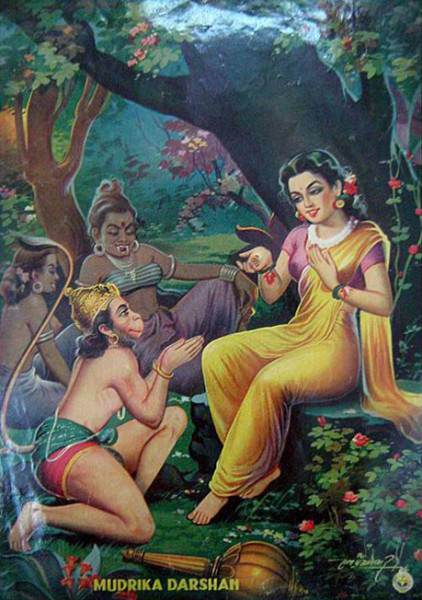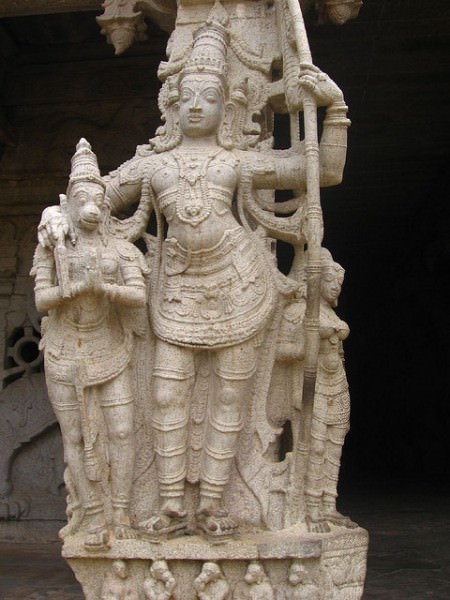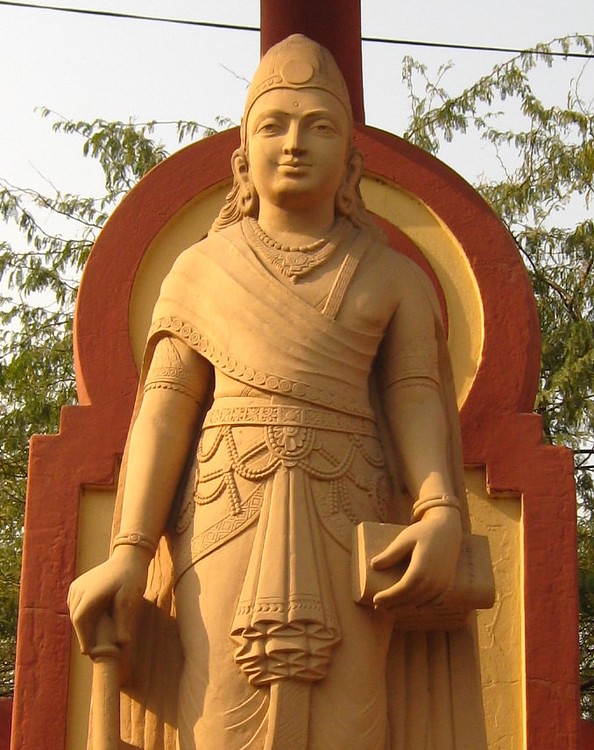Hanuman › Chandragupta Maurya » Ancient origins
Articles and Definitions › Contents
- Hanuman › Who Was
- Chandragupta Maurya › Who Was
Ancient civilizations › Historical and archaeological sites
Hanuman › Who Was
Definition and Origins

Hanuman is one of several zoomorphic characters in Indian mythology, but is the only wholly animal figure who is revered as a god today. The mythic texts speak of him as a monkey child of the Wind God, as possessing enormous strength, keen intellect and a mastery over the Vedas and other branches of learning. He is also an unquestioning devotee of Rama, the hero of the epic Ramayana, and has the ability to take on any form he wishes.
HANUMAN IN THE RAMAYANA
The first reference to Hanuman in the epic Ramayana is casual - as a "group of monkeys" - and one has no inkling of the large role that he will go on to play in the remainder of the story. Ravana, a demon, abducted Sita, wife of the exiled prince Rama.When Ravana was carrying away Sita in his air-borne chariot, Sita saw some monkeys atop a mountain and threw down her ornaments, hoping that monkeys with ornaments would attract the attention of her husband Rama, who would surely be searching for her in the same forest. Hanuman was one of these four monkeys. This monkey group was instrumental in giving Rama key information about Sita. They helped him build a bridge across the seas, and cross over with a monkey army that successfully stormed the demon stronghold and freed Sita.
Hanuman's role in the battle between Rama and Ravana is huge. He is the one who flies across the oceans (he is Wind's child), locates the exact place where Sita is imprisoned and brings this information back to Rama. While within the demon fort on his quest for Sita, he sets the entire place on fire and warns Ravana about an impending attack unless Sita is returned unharmed.
FROM HIS FATHER, THE WIND GOD, HANUMAN INHERITS HIS MIGHT & SPEED. HE IS ALSO A SHAPESHIFTER WHO CAN INCREASE & DECREASE HIS BODY SIZE AT WILL.
During the Rama-Ravana battle, Hanuman not only kills several demon generals but also brings Rama's brother back to life.How does he do that? Well, it so happens that Rama's brother is mortally wounded by Ravana's son, and the monkey-army-physician opines that the only things that can save the life of the younger prince are four specific herbs that grow on the Himalayan slopes. The catch? The battle is raging on in Lanka, across the southernmost tip of the country while the Himalayas are far up north, and the herbs are needed within the next few hours, before the new day dawns. Hanuman leaps up into the air, flies northwards at lightning speed, and alights atop the Himalayas. This is where things start to become confusing: the monkey-physician had said that medicine herbs glow in their own light and that it should be easy, therefore, to spot them. What Hanuman sees, however, is an entire mountain aglow with herbs of all kinds, each emitting its own peculiar light. Being unable to identify the exact four herbs that the physician had described, Hanuman uproots the entire mountain and carries it back to the battlefield. The physician gets his herbs, the near-dead prince is brought back his life, and, so strong is the effect of the mountain teeming with a thousand fragrant herbs that other monkeys who had fallen in battle are also healed just by inhaling the medicine-scented mountain air.

Hanuman finds Sita
Hanuman is described in the epic as one of extremely pleasant visage, perfect diction, elegant speech, and faultless manners.He is also described as being knowledgeable in the three Vedas. From his father, the Wind God, he inherits his might and speed. He is also a shapeshifter who can increase and decrease his body size at will.
HANUMAN IN THE MAHABHARAT
The Mahabharat is an epic about two branches of a family warring for a throne. One of the princes in the Mahabharat is also a son of the Wind God and it is to him that Hanuman's makes his only appearance in this epic. This prince, named Bhima, was as mighty as the wind and had once wandered into a large banana grove, which he proceeded to randomly destroy. While tearing down fruit and uprooting trees, he saw an old monkey dozing by the wayside, its tail lying right across the grove path.Bhima ordered the monkey to move its tail aside; the monkey opened his eyes and said it was rather weak and if the prince could be kind enough to lift it gently aside he would be grateful. Bhima, not given to either patience or conversations with lesser beings, bent to pick the monkey up by its tail, intending to hurl it across the banana trees. However, to his surprise, try as he might, he could not move even a whisker of the tail. It transpired that the monkey was none other than Hanuman, the mightiest being on earth. "Strength should not be trifled with; neither should it be something to be vain of", or words to similar effect, were what Hanuman told the chastened Bhima.
As a mark of affection to Bhima, Hanuman agreed to reside on the flag of Bhima's younger brother Arjuna 's chariot. It is for this reason that Arjuna is called Kapi-dhwaj ( kapi = monkey, dhwaj = flag, kapi+dhwaj = ape-bannered). During the final terrible Mahabharat war, Arjun's war cries were amplified by the roar that would emanate from the ape emblem on his flagstaff, driving fear into the hearts of his enemies.

Rama & Hanuman
HANUMAN IN THE PURANAS
Hanuman is the child of the Wind God and the princess Anjana. He is referred to by his metronymic, Anjaneya, as often as his patronymic, which seems to be the norm in most of the Hindu mythological texts. The various Puranas say that Anjana was married to the monkey chief Kesari. The couple prayed to Shiva for a son, and Hanuman was born to them from an aspect of Shiva, through the agency of the Wind God. Thus, Hanuman has two patronyms: Vayu-putra (Wind's son) as well as Kesari-nandan (Kesari's son).
So why is he called Hanuman then? The story is this: as soon as he was born, Hanuman grew up to a considerable size, jumped about like all monkeys do, and asked his mother what he should eat. Anjana pointed to the rising sun, a sphere of red in the golden dawn, and told him that anything that looked like that (ie ripe fruits) was his food. Hanuman mistook the sun itself to be a ripe fruit and leapt up in the air to grab it. The king of gods, seeing a dark streak speeding across the sky towards the sun as if to swallow it whole, was alarmed and hurled his thunderbolt at the flying figure. Whereupon Hanuman roared with laughter and said, "Do you not know, King, that I am unslayable? I am born of Shiva, how can your thunderbolt do anything to me? However, just so the Worlds do not laugh at you, I allow your weapon to scratch my chin". Or, words to that effect. Thus, the honour of the king of gods was retained, the infallible thunderbolt hit its target, the monkey child got his chin disfigured, and came to be known as Hanuman ( hanu = chin; man = of, with, bearing, having; hanu+man =he of [broken] chin).
The Puranas also tell us that Hanuman was taught the Vedas and all other branches of learning by Sun God himself, Surya.He learnt his lessons by trotting alongside the Sun's chariot as it moved across the sky.

Hanuman
HANUMAN IN LATER LITERATURE
During the 16th CE, a poet called Tulsidas retold the Ramayana in the vernacular Awadhi language (rather than the academic Sanskrit ) and also composed several hymns to the gods. One such hymn, the Hanuman Chalisa, continues to be recited today by thousands of people. This canticle of about 40 verses celebrates all of the qualities that Hanuman came to signify over the centuries: strength, devotion, celibacy, and righteousness. Hanuman became a god. In an extract from the Hanuman Chalisa,
भूत पिशाच निकट नहिं आवै।
महाबीर जब नाम सुनावै॥
नासै रोग हरै सब पीरा।
जपत निरंतर हनुमत बीरा॥Demons and ghosts do not come near
If they hear the mighty one's name
Diseases die, sorrows disappear
If one constantly chants Hanuman's name
HANUMAN IN THE 21ST CENTURY
Hanuman is worshipped as a god in several parts of India today. It is almost de rigueur to find a small shrine to him in police stations and wrestling clubs across the country, especially in the north. Outside of India, Hanuman is known in countries which were influenced by the Hindu culture such as Indonesia, Thailand, and Malaysia.
Hanuman is a recurring figure in the panels and motifs of the Ramayana that adorn the temples that were built over the centuries in India. He is most often depicted with his favourite weapon, the mace. He is also often depicted as flying across the skies, one hand holding aloft the mountain of herbs and the other a mace.
Chandragupta Maurya › Who Was
Definition and Origins

Indian Emperor Chandragupta Maurya lived from 340-298 BCE and was the first ruler of the Mauryan Empire. He ruled from 322-298 BCE; he was the father of Emperor Bindusara and grandfather of Emperor Ashoka, who was the third Mauryan ruler and under whose reign the Mauryan Empire reached its full power and became the largest empire ever in the Indian subcontinent and one of the world's largest empires at that time.
Before the time of Chandragupta, India was mostly composed of a number of small independent states, with the exception of the Magadha kingdom, a realm that controlled most of Northern India, which was ruled by the Nanda dynasty. Chandragupta began a process that would unify India for the first time in history.
THE LIBERATION OF INDIA
During 326 BCE, while fighting his way into India, Alexander the Great came across the army of King Porus, the ruler of the local state of Paurava, located in modern day Punjab. After fighting to his last breath, King Porus surrendered to Alexander, who was impressed by the courage and stature of his enemy. Alexander made Porus his ally and turned him into king of all conquered India as a Macedonian tributary. Shortly after this, Alexander's army refused to go any further into Asia; his men mutinied and thus the Macedonian army turned back and left India.
CHANDRAGUPTA'S COURAGE, COUPLED WITH KAUTILYA CHANAKYA ’S INTELLIGENCE, TURNED THE MAURYAN EMPIRE INTO ONE OF THE MOST POWERFUL GOVERNMENTS OF THE TIME.
Chandragupta was a noble member of the Kshatriya caste (the warrior-ruler caste) and the main proponent for removing all fragments of Macedonian influence form India. He was related to the Nanda family, but he was an exile. Ironically enough, Chandragupta was a fugitive in the camp of Alexander the Great during the time of his exile, and it is possible that he personally met Alexander the Great.
With the help of his wise chief advisor and future prime minister Kautilya Chanakya, Chandragupta raised a small army. The military strength lacked by Chandragupta's force was balanced out by the cunning strategies used by Kautilya Chanakya.Chandragupta entered the capital of the Magadha kingdom, Pataliputra, where he triggered a civil war using Kautilya Chanakya's intelligence network. In 322 BCE he finally seized the throne putting an end to the Nanda dynasty, and he established the Mauryan Dynasty which would rule India until 185 BCE. After this victory, Chandragupta fought and defeated Alexander's generals located in Gandhara, present day Afghanistan. Following these successful campaigns, Chandragupta was seen as a brave leader who defeated part of the Greek invaders and ended the corrupt Nanda government, thus gaining wide public support.
Chandragupta's courage, coupled with Kautilya Chanakya's intelligence, soon turned the Mauryan Empire into one of the most powerful governments at that time. Pataliputra remained the imperial capital, and the initial territory controlled by Chandragupta extended all across Northern India from the Indus River in the west to the Bay of Bengal in the East.
After the death of Alexander the Great in 323 BCE, the Eastern territories controlled by the Macedonians fell into the hands of General Seleucus, including the region of the Punjab, which today is part of Northern India and Eastern Pakistan. Seleucus was busy enough with what was happening on the western borders, so Chandragupta saw a tempting opportunity and launched an attack on Seleucus and captured a big portion of what today is Pakistan and Afghanistan. In 305 BCE, Chandragupta signed a treaty with Seleucus in which both rulers established borders, and the Punjab was given to Chandragupta in return for 500 war elephants.

Chandragupta Maurya's Empire
THE GOVERNMENT OF CHANDRAGUPTA & IMPERIAL EXPANSION
During the government of Chandragupta, we find the Greek Magasthenes, an ambassador of Seleucus, who lived in the court of Pataliputra from 317-312 BCE. He wrote many different reports about India and although his original work is lost, we can piece together some information found in subsequent works. He reported that the Indians:
[...] never drink wine except at sacrifice [...] The simplicity of their laws and their contracts is proved by the fact that they seldom go to law. They have no suits about pledges and deposits, nor do they require either seals or witnesses, but make their deposits and confide in each other.
(Durant, 441)
Magasthenes also reports that Pataliputra was nine miles in length and about two miles in width. Chandragupta's palace was full of luxuries and all type of ostentatious possessions. Inside his palace, Chandragupta paid the price of ascending to power through the use of violence: he lived in it for 24 years, almost as a recluse, with very limited public exposure, solely devoted to the growth of the empire. He managed to extend his empire westwards and became the master of all Northern India.According to the reports of Magasthenes, Chandragupta's army was composed of 600,000 foot soldiers, 30,000 horses, and 9,000 war elephants.
After becoming the master of all Northern India, Chandragupta began a campaign to conquer the southern half of the Indian subcontinent. Battle after battle, the Mauryan forces absorbed most of the independent Indian states until eventually, in 300 BCE, the borders of the Mauryan Empire extended southward into the Deccan Plateau. Chandragupta, however, failed to annex the small kingdom of Kalinga in present day Odisha in central-eastern India, on the Bay of Bengal. This pending conquest would be completed in 260 BCE by Emperor Ashoka.
ABDICATION & DEATH
In 298 BCE, Chandragupta voluntarily abdicated the throne in favour of his son Bindusara, who became the new Mauryan emperor. What we know after this point seems closer to legend than an actual historical account. It is said that Chandragupta turned into an ascetic and follower of Jainism. Jain tradition claims that Chandragupta migrated south and, consistent with the beliefs of Jainism, he starved himself to death inside a cave. This event supposedly took place in Sravana Belgola, a cityabout 150 kilometers away from Bangalore, which is one of the most important places of pilgrimage in Jainism.
See other Related Contents ››
LICENSE:
Article based on information obtained from these sources:with permission from the Website Ancient History Encyclopedia
Content is available under License Creative Commons: Attribution-NonCommercial-ShareAlike 3.0 Unported. CC-BY-NC-SA License